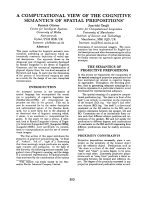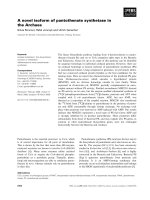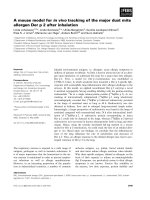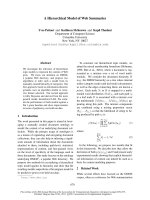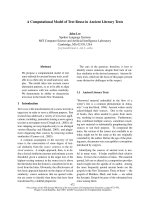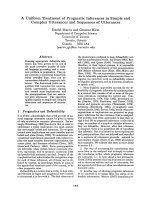Báo cáo khoa học: "A Computational Model of Text Reuse in Ancient Literary Texts" potx
Bạn đang xem bản rút gọn của tài liệu. Xem và tải ngay bản đầy đủ của tài liệu tại đây (592.68 KB, 8 trang )
Proceedings of the 45th Annual Meeting of the Association of Computational Linguistics, pages 472–479,
Prague, Czech Republic, June 2007.
c
2007 Association for Computational Linguistics
A Computational Model of Text Reuse in Ancient Literary Texts
John Lee
Spoken Language Systems
MIT Computer Science and Artificial Intelligence Laboratory
Cambridge, MA 02139, USA
Abstract
We propose a computational model of text
reuse tailored for ancient literary texts, avail-
able to us often only in small and noisy sam-
ples. The model takes into account source
alternation patterns, so as to be able to align
even sentences with low surface similarity.
We demonstrate its ability to characterize
text reuse in the Greek New Testament.
1 Introduction
Text reuse is the transformation of a source text into a
target text in order to serve a different purpose. Past
research has addressed a variety of text-reuse appli-
cations, including: journalists turning a news agency
text into a newspaper story (Clough et al., 2002); ed-
itors adapting an encyclopedia entry to an abridged
version (Barzilay and Elhadad, 2003); and plagia-
rizers disguising their sources by removing surface
similarities (Uzuner et al., 2005).
A common assumption in the recovery of text
reuse is the conservation of some degree of lexi-
cal similarity from the source sentence to the de-
rived sentence. A simple approach, then, is to de-
fine a lexical similarity measure and estimate a score
threshold; given a sentence in the target text, if the
highest-scoring sentence in the source text is above
the threshold, then the former is considered to be de-
rived from the latter. Obviously, the effectiveness of
this basic approach depends on the degree of lexical
similarity: source sentences that are quoted verba-
tim are easier to identify than those that have been
transformed by a skillful plagiarizer.
The crux of the question, therefore, is how to
identify source sentences despite their lack of sur-
face similarity to the derived sentences. Ancient lit-
erary texts, which are the focus of this paper, present
some distinctive challenges in this respect.
1.1 Ancient Literary Texts
“Borrowed material embedded in the flow of a
writer’s text is a common phenomenon in Antiq-
uity.” (van den Hoek, 1996). Ancient writers rarely
acknowledged their sources. Due to the scarcity
of books, they often needed to quote from mem-
ory, resulting in inexact quotations. Furthermore,
they combined multiple sources, sometimes insert-
ing new material or substantially paraphrasing their
sources to suit their purpose. To compound the
noise, the version of the source text available to us
today might not be the same as the one originally
consulted by the author. Before the age of the print-
ing press, documents were susceptible to corruptions
introduced by copyists.
Identifying the sources of ancient texts is use-
ful in many ways. It helps establish their relative
dates. It traces the evolution of ideas. The material
quoted, left out or altered in a composition provides
much insight into the agenda of its author. Among
the more frequently quoted ancient books are the
gospels in the New Testament. Three of them — the
gospels of Matthew, Mark, and Luke — are called
the Synoptic Gospels because of the substantial text
reuse among them.
472
Target verses (English translation) Target verses (original Greek) Source verses (original Greek)
Luke 9:30-33 Luke 9:30-33 Mark 9:4-5
(9:30) And, behold, (9:30) kai idou (9:4) kai
¯
ophth
¯
e autois
there talked with him two men, andres duo sunelaloun aut
¯
o
¯
Elias sun M
¯
ousei kai
which were Moses and Elias. hoitines
¯
esan M
¯
ous
¯
es kai
¯
Elias
¯
esan sullalountes t
¯
o I
¯
esou
(9:31) Who appeared in glory, (9:31) hoi ophthentes en dox
¯
e (no obvious source verse)
(9:32) But Peter and they that were with him (9:32) ho de Petros kai hoi sun aut
¯
o (no obvious source verse)
(9:33) And it came to pass, (9:33) kai egeneto en t
¯
o diach
¯
orizesthai
as they departed from him, autous ap’ autou eipen ho Petros (9:5) kai apokritheis ho Petros
Peter said unto Jesus, Master, pros ton I
¯
esoun epistata legei t
¯
o I
¯
esou rabbi
it is good for us to be here: kalon estin h
¯
emas h
¯
ode einai kalon estin h
¯
emas h
¯
ode einai
and let us make kai poi
¯
es
¯
omen sk
¯
enas treis kai poi
¯
es
¯
omen treis sk
¯
enas
three tabernacles; one for thee, mian soi kai mian M
¯
ousei soi mian kai M
¯
ousei mian
and one for Moses, and one for Elias: kai mian
¯
Elia kai
¯
Elia mian
not knowing what he said. m
¯
e eid
¯
os ho legei
Table 1: Luke 9:30-33 and their source verses in the Gospel of Mark. The Greek words with common
stems in the target and source verses are bolded. The King James Version English translation is included for
reference. §1.2 comments on the text reuse in these verses.
1.2 Synoptic Gospels
The nature of text reuse among the Synoptics spans
a wide spectrum. On the one hand, some revered
verses, such as the sayings of Jesus or the apostles,
were preserved verbatim. Such is the case with Pe-
ter’s short speech in the second half of Luke 9:33
(see Table 1). On the other hand, unimportant de-
tails may be deleted, and new information weaved
in from other sources or oral traditions. For ex-
ample, “Luke often edits the introductions to new
sections with the greatest independence” (Taylor,
1972). To complicate matters, it is believed by some
researchers that the version of the Gospel of Mark
used by Luke was a more primitive version, cus-
tomarily called Proto-Mark, which is no longer ex-
tant (Boismard, 1972). Continuing our example in
Table 1, verses 9:31-32 have no obvious counter-
parts in the Gospel of Mark. Some researchers have
attributed them to an earlier version of Mark (Bo-
ismard, 1972) or to Luke’s “redactional tenden-
cies” (Bovon, 2002).
The result is that some verses bear little resem-
blance to their sources, due to extensive redaction,
or to discrepancies between different versions of the
source text. In the first case, any surface similarity
score alone is unlikely to be effective. In the second,
even deep semantic analysis might not suffice.
1.3 Goals
One property of text reuse that has not been explored
in past research is source alternation patterns. For
example, “it is well known that sections of Luke de-
rived from Mark and those of other origins are ar-
ranged in continuous blocks” (Cadbury, 1920). This
notion can be formalized with features on the blocks
and order of the source sentences. The first goal of
this paper is to leverage source alternation patterns
to optimize the global text reuse hypothesis.
Scholars of ancient texts tend to express their
analyses qualitatively. We attempt to translate their
insights into a quantitative model. To our best
knowledge, this is the first sentence-level, quantita-
tive text-reuse model proposed for ancient texts. Our
second goal is thus to bring a quantitative approach
to source analysis of ancient texts.
2 Previous Work
Text reuse is analyzed at the document level in
(Clough et al., 2002), which classifies newspaper
articles as wholly, partially, or non-derived from
a news agency text. The hapax legomena, and
sentence alignment based on N-gram overlap, are
found to be the most useful features. Considering a
document as a whole mitigates the problem of low
similarity scores for some of the derived sentences.
473
1 2 3 4 5 6 7 8 9 10 1112 1314 15 16
1
2
3
4
5
6
7
8
9
10
11
12
13
14
15
16
17
18
19
20
21
22
23
24
Mark
Luke
Figure 1: A dot-plot of the cosine similarity mea-
sure between the Gospel of Luke and the Gospel of
Mark. The number on the axes represent chapters.
The thick diagonal lines reflect regions of high lexi-
cal similarity between the two gospels.
At the level of short passages or sentences, (Hatzi-
vassiloglou et al., 1999) goes beyond N-gram, tak-
ing advantage of WordNet synonyms, as well as or-
dering and distance between shared words. (Barzi-
lay and Elhadad, 2003) shows that the simple cosine
similarity score can be effective when used in con-
junction with paragraph clustering. A more detailed
comparison with this work follows in §4.2.
In the humanities, reused material in the writ-
ings of Plutarch (Helmbold and O’Neil, 1959) and
Clement (van den Hoek, 1996) have been manually
classified as quotations, reminiscences, references
or paraphrases. Studies on the Synoptics have been
limited to N-gram overlap, notably (Honor
´
e, 1968)
and (Miyake et al., 2004).
Text Hypothesis Researcher Model
L
train
L
train.B
(Bovon, 2002) B
L
train.J
(Jeremias, 1966) J
L
test
L
test.B
(Bovon, 2003)
L
test.J
(Jeremias, 1966)
Table 2: Two models of text reuse of Mark in L
train
are trained on two different text-reuse hypotheses:
The B model is on the hypothesis in (Bovon, 2002),
and the J model, on (Jeremias, 1966). These two
models then predict the text-reuse in L
test
.
3 Data
We assume the Two-Document Theory
1
, which hy-
pothesizes that the Gospel of Luke and the Gospel
of Matthew have as their common sources two doc-
uments: the Gospel of Mark, and a lost text custom-
arily denoted Q. In particular, we will consider the
Gospel of Luke
2
as the target text, and the Gospel of
Mark as the source text.
We use a Greek New Testament corpus prepared
by the Center for Computer Analysis of Texts at the
University of Pennsylvania
3
, based on the text vari-
ant from the United Bible Society. The text-reuse
hypotheses (i.e., lists of verses deemed to be de-
rived from Mark) of Franc¸ois Bovon (Bovon, 2002;
Bovon, 2003) and Joachim Jeremias (Jeremias,
1966) are used. Table 2 presents our notations.
Luke 1:1 to 9:50 (L
train
, 458 verses) Chapters 1
and 2, narratives of the births of Jesus and John
the Baptist, are based on non-Markan sources.
Verses 3:1 to 9:50 describe Jesus’ activities in
Galilee, a substantial part of which is derived
from Mark.
Luke Chapters 22 to 24 (L
test
, 179 verses) These
chapters, known as the Passion Narrative, serve
as our test text. Markan sources were behind
38% of the verses, according to Bovon, and 7%
according to Jeremias.
1
This theory (Streeter, 1930) is currently accepted by a ma-
jority of researchers. It guides our choice of experimental data,
but our model does not depend on its validity.
2
We do not consider the Gospel of Matthew or Q in this
study. Verses from Luke 9:51 to the end of chapter 21 are
also not considered, since their sources are difficult to ascertain
(Bovon, 2002).
3
Obtained through Peter Ballard (personal communication)
474
4 Approach
For each verse in the target text (a “target verse”), we
would like to determine whether it is derived from a
verse in the source text (a “source verse”) and, if so,
which one.
Following the framework of global linear models
in (Collins, 2002), we cast this task as learning a
mapping F from input verses x ∈ X to a text-reuse
hypothesis y ∈ Y ∪ {}. X is the set of verses in
the target text. In our case, x
train
= (x
1
, . . . , x
458
)
is the sequence of verses in L
train
, and x
test
is that
of L
test
. Y is the set of verses in the source text.
Say the sequence y = (y
1
, . . . , y
n
) is the text-reuse
hypothesis for x = (x
1
, . . . , x
n
). If y
i
is , then x
i
is
not derived from the source text; otherwise, y
i
is the
source verse for x
i
. The set of candidates GEN(x)
contains all possible sequences for y, and Θ is the
parameter vector. The mapping F is thus:
F (x) = arg max
y∈GEN(x)
Φ(x, y) · Θ
4.1 Features
Given the small amount of training data available
4
,
the feature space must be kept small to avoid overfit-
ting. Starting with the cosine similarity score as the
baseline feature, we progressively enrich the model
with the following features:
Cosine Similarity [Sim] Treating a target verse as
a query to the set of source verses, we com-
pute the cosine similarity, weighted with tf.idf,
for each pair of source verse and target verse
5
.
This standard bag-of-words approach is appro-
priate for Greek, a relatively free word-order
language. Figure 1 plots this feature on Luke
and Mark.
Non-derived verses are assigned a constant
score in lieu of the cosine similarity. We will
refer to this constant as the cosine threshold
(C): when the Sim feature alone is used, the
constant effectively acts as the threshold above
which target verses are considered to be de-
rived. If w
i
, w
j
are the vectors of words of a
4
Note that the training set consists of only one x
train
—
the Gospel of Luke. Luke’s only other book, the Acts of the
Apostles, contains few identifiable reused material.
5
A targert verse is also allowed to match two consecutive
source verses.
target verse and a candidate source verse, then:
sim(i, j) =
w
i
·w
j
w
i
·w
j
if derived
C otherwise
Number of Blocks [Block] Luke can be viewed
as alternating between Mark and non-Markan
material, and he “prefers to pick up al-
ternatively entire blocks rather than isolated
units.” (Bovon, 2002) We will use the term
Markan block to refer to a sequence of verses
that are derived from Mark. A verse with a
low cosine score, but positioned in the mid-
dle of a Markan block, is likely to be derived.
Conversely, an isolated verse in the middle of
a non-Markan block, even with a high cosine
score, is unlikely to be so. The heavier the
weight of this feature, the fewer blocks are pre-
ferred.
Source Proximity [Prox] When two derived
verses are close to one another, their respective
source verses are also likely to be close to one
another; in other words, derived verses tend to
form “continuous blocks” (Cadbury, 1920).
We define distance as the number of verses sep-
arating two verses. For each pair of consec-
utive target verses, we take the inverse of the
distance between their source verses. This fea-
ture is thus intended to discourage a derived
verse from being aligned with a source verse
that shares some lexical similarities by chance,
but is far away from other source verses in the
Markan block.
Source Order [Order] “Whenever Luke follows
the Markan narrative in his own gospel he
follows painstakingly the Markan order”, and
hence “deviations in the order of the material
must therefore be regarded as indications that
Luke is not following Mark.” (Jeremias, 1966).
This feature is a binary function on two consec-
utive derived verses, indicating whether their
source verses are in order. A positive weight
for this feature would favor an alignment that
respects the order of the source text.
In cases where there are no obvious source verses,
such as Luke 9:30-31 in Table 1, the source order
475
and proximity would be disrupted. To mitigate this
issue, we allow the Prox and Order features the
option of skipping up to two verses within a Markan
block in the target text. In our example, Luke 9:30
can skip to 9:32, preserving the source proximity
and order between their source verses, Mark 9:4 and
9:5.
Another potential feature is the occurrence of
function words characteristic of Luke (Rehkopf,
1959), along the same lines as in the study of the
Federalist Papers (Mosteller and Wallace, 1964).
These stylistic indicators, however, are unlikely
to be as helpful on the sentence level as on the
document level. Furthermore, Luke “reworks [his
sources] to an extent that, within his entire composi-
tion, the sources rarely come to light in their original
independent form” (Bovon, 2002). The significance
of the presence of these indicators, therefore, is di-
minished.
4.2 Discussion
This model is both a simplification of and an ex-
tension to the one advocated in (Barzilay and El-
hadad, 2003). On the one hand, we perform no para-
graph clustering or mapping before sentence align-
ment. Ancient texts are rarely divided into para-
graphs, nor are they likely to be large enough for
statistical methods on clustering. Instead, we rely
on the Prox feature to encourage source verses to
stay close to each other in the alignment.
On the other hand, our model makes two exten-
sions to the “Micro Alignment” step in (Barzilay
and Elhadad, 2003). First, we add the Block and
Prox features to capture source alternation patterns.
Second, we place no hard restrictions on the re-
ordering of the source text, opting instead for a soft
preference for maintaining the source order through
the Order feature. In contrast, deviation from the
source order is limited to “flips” between two sen-
tences in (Barzilay and Elhadad, 2003), an assump-
tion that is not valid in the Synoptics
6
.
4.3 Evaluation Metric
Our model can make two types of errors: source er-
ror, when it predicts a non-derived target verse to
be derived, or vice versa; and alignment error, when
6
For example, Luke 6:12-19 transposes Mark 3:7-12 and
Mark 3:13-19 (Bovon, 2002).
it correctly predicts a target verse to be derived, but
aligns it to the wrong source verse.
Correspondingly, we interpret the output of our
model at two levels: as a binary output, i.e., the
target verse is either “derived” or “non-derived”;
or, as an alignment of the target verse to a source
verse. We measure the precision and recall of the
target verses at both levels, yielding two F-measures,
F
source
and F
align
7
.
Literary dependencies in the Synoptics are typi-
cally expressed as pairs of pericopes (short, coher-
ent passages), for example, “Luke 22:47-53 // Mark
14:43-52”. Likewise, for F
align
, we consider the
output correct if the hypothesized source verse lies
within the pericope
8
.
5 Experiments
This section presents experiments for evaluating our
text-reuse model. §5.1 gives some implementa-
tion details. §5.2 describes the training process,
which uses text-reuse hypotheses of two different re-
searchers (L
train.B
and L
train.J
) on the same train-
ing text. The two resulting models thus represent
two different opinions on how Luke re-used Mark;
they then produce two hypotheses on the test text
(
ˆ
L
test.B
and
ˆ
L
test.J
).
Evaluations of these hypotheses follow. In §5.3,
we compare them with the hypotheses of the same
two researchers on the test text (L
test.B
and L
test.J
).
In §5.3, we compare them with the hypotheses of
seven other representative researchers (Neirynck,
1973). Ideally, when the model is trained on a par-
ticular researcher’s hypothesis on the train text, its
hypothesis on the test text should be closest to the
one proposed by the same researcher.
5.1 Implementation
Suppose we align the i
th
target verse to the k
th
source verse or to . Using dynamic programming,
their score is the cosine similarity score sim(i, k),
added to the best alignment state up to the (i − 1 −
skip)
th
target verse, where skip can vary from 0 to
2 (see §4.1). If the j
th
source verse is the aligned
7
Note that F
align
is never higher than F
source
since it pe-
nalizes both source and alignment errors.
8
A more fine-grained metric is individual verse alignment.
This is unfortunately difficult to measure. As discussed in §1.2,
many derived verses have no clear source verses.
476
Model B J
Train Hyp L
train.B
L
train.J
Metric F
source
F
align
F
source
F
align
Sim 0.760 0.646 0.748 0.635
+Block 0.961 0.728 0.977 0.743
All 0.985 0.949 0.983 0.936
Table 3: Performance on the training text, L
train
.
The features are accumulative; All refers to the full
feature set.
verse in this state, then score(i, k) is:
sim(i, k) + max
j,skip
{score(i − 1 − skip, j)
+w
prox
· prox(j, k) + w
order
· order(j, k)
−w
block
· block(j, k)}
If both j and k are aligned (i.e., not ), then:
prox(j, k) =
1
dist(j, k)
order(j, k) = 1 if j ≥ k
block(j, k) = 1 if starting new block
Otherwise these are set to zero.
5.2 Training Results
The model takes only four parameters: the weights
for the Block, Prox and Order features, as well
as the cosine threshold (C). They are empirically
optimized, accurate to 0.01, on the two training hy-
potheses listed in Table 2, yielding two models, B
and J.
Table 3 shows the increasing accuracy of both
models in describing the text reuse in L
train
as
more features are incorporated. The Block fea-
ture contributes most in predicting the block bound-
aries, as seen in the jump of F
source
from Sim to
+Block. The Prox and Order features substan-
tially improve the alignment, boosting the F
align
from +Block to All.
Both models B and J fit their respective hypothe-
ses to very high degrees. For B, the only significant
source error occurs in Luke 8:1-4, which are derived
verses with low similarity scores. They are transi-
tional verses at the beginning of a Markan block. For
Model B J
Test Hyp L
test.B
L
test.J
Metric F
source
F
align
F
source
F
align
Sim 0.579 0.382 0.186 0.144
+Block 0.671 0.329 0.743 0.400
All 0.779 0.565 0.839 0.839
Table 5: Performance on the test text, L
test
.
J, the pericope Luke 6:12-16 is wrongly predicted as
derived.
Most alignment errors are misalignments to a
neighboring pericope, typically for verses located
near the boundary between two pericopes. Due to
their low similarity scores, the model was unable
to decide if they belong to the end of the preceding
pericope or to the beginning of the following one.
5.3 Test Results
The two models trained in §5.2, B and J, are intended
to capture the characteristics of text reuse in L
train
according to two different researchers. When ap-
plied on the test text, L
test
, they produce two hy-
potheses,
ˆ
L
test.B
and
ˆ
L
test.J
. Ideally, they should
be similar to the hypotheses offered by the same re-
searchers (namely, L
test.B
and L
test.J
), and dissim-
ilar to those by other researchers. We analyze the
first aspect in §5.3, and the second aspect in §5.3.
Comparison with Bovon and Jeremias
Table 4 shows the output of B and J on L
test
. As
more features are added, their output increasingly
resemble L
test.B
and L
test.J
, as shown in Table 5.
Both
ˆ
L
test.B
and
ˆ
L
test.J
contain the same number
of Markan blocks as the “reference” hypotheses pro-
posed by the respective scholars. In both cases, the
pericope Luke 22:24-30 is correctly assigned as non-
derived, despite their relatively high cosine scores.
This illustrates the effect of the Block feature.
As for source errors, both B and J mistakenly as-
sign Luke 22:15-18 as Markan, attracted by the high
similarity score of Luke 22:18 with Mark 14:25.
B, in addition, attributes another pericope to Mark
where Bovon does not. Despite the penalty of lower
source proximity, it wrongly aligned Luke 23:37-38
to Mark 15:2, misled by a specific title of Jesus that
happens to be present in both.
477
Chp 22 23
Sim xx x-x-xxxxxx-xxxxx-xx x xxx-x xx x-xxx-xxxxxx-xx-x-xxxxx-x x xx x xxx xx x-x-xxx xxxx xxxxx
All xxxxxxxxxxxxxxxxxx xxxxxxxxxxxxxxxxxxxxxxxxxxxx xxxxxxxxxxxxxxxxx
Bov xxxxxxxxxxxxxx xxxxxxxxxxxxxxxxxxxxxxxxxxxxxx xxxxxxxxxxxxx
Sim xx x-x-xxxxxx-xxxxx-xx x xxx-x xx x-xxx-xxxxxx-xx-x-xxxxx-x x xx x xxx xx x-x-xxx xxxx xxxxx
All xxxxxxxxxxxxxxxxxx
Jer xxxxxxxxxxxxx
Gru xxxxxxxxxxxxx xxx xx xx x xx x xx-x xxx
Haw xxxxxxxxxxxxx x x x xx xxx x x x x x xxx xx
Reh xxxxxxxxxxxxx x xx x
Snd xxx xx xxxxxxxxxx xxx
Srm xxxxxxxxxxxxxx xxx xx
Str xxxxxxxxxxxxx x x x xx xxxxxxxxxx x x x xx xx x xxx xx
Tay xxxxxxxxxxxxx x x x x-xxxxxxxxxx x x x x xx xxxxxx
Chp 24
Sim xxx x-xx x x xxx-x x x-xxx-x (Model B Sim)
All (Model B All)
Bov xxxxxxxxxxx (Bovon)
Sim xxx x-xx x x xxx-x x x-xxx-x (Model J Sim)
All (Model J All)
Jer (Jeremias)
Gru -x x (Grundmann)
Haw x (Hawkins)
Reh (Rehkopf)
Snd -x x x (Schneider)
Srm (Sch
¨
urmann)
Str x (Streeter)
Tay x (Taylor)
Table 4: Output of models B and J, and scholarly hypotheses on the test text, L
test
. The symbol ‘x’ indicates
that the verse is derived from Mark, and ‘-’ indicates that it is not. The hypothesis from (Bovon, 2003),
labelled ‘Bov’, is compared with the Sim (baseline) output and the All output of model B, as detailed
in Table 5. The hypothesis from (Jeremias, 1966), ‘Jer’, is similarly compared with outputs of model J.
Seven other scholarly hypotheses are also listed.
Elsewhere, B is more conservative than Bovon in
proposing Markan derivation. For instance, the peri-
cope Luke 24:1-11 is deemed non-derived, an opin-
ion (partially) shared by some of the other seven re-
searchers.
Comparison with Other Hypotheses
Another way of evaluating the output of B and
J is to compare them with the hypotheses of other
researchers. As shown in Table 6,
ˆ
L
test.B
is more
similar to L
test.B
than to the hypothesis of other
researchers
9
. In other words, when the model is
trained on Bovon’s text-reuse hypothesis on the train
text, its prediction on the test text matches most
closely with that of the same researcher, Bovon.
9
This is the list of researchers whose opinions on L
test
are considered representative by (Neirynck, 1973). We have
simplified their hypotheses, considering those “partially assim-
ilated” and “reflect the influence of Mark” to be non-derived
from Mark.
Hypothesis B (
ˆ
L
test.B
) J (
ˆ
L
test.J
)
Bovon (L
test.B
) 0.838 0.676
Jeremias (L
test.J
) 0.721 0.972
Grundmann 0.726 0.866
Hawkins 0.737 0.877
Rehkopf 0.721 0.950
Schneider 0.676 0.782
Sch
¨
urmann 0.698 0.950
Streeter 0.771 0.821
Taylor 0.793 0.821
Table 6: Comparison of the output of the models
B and J with hypotheses by prominent researchers
listed in (Neirynck, 1973). The metric is the per-
centage of verses deemed by both hypotheses to be
“derived”, or “non-derived”.
478
The differences between Bovon and the next two
most similar hypotheses, Taylor and Streeter, are
not statistically significant according to McNemar’s
test (p = 0.27 and p = 0.10 respectively), possi-
bly a reflection of the small size of L
test
; the dif-
ferences are significant, however, with all other hy-
potheses (p < 0.05). Similar results are observed
for Jeremias and
ˆ
L
test.J
.
6 Conclusion & Future Work
We have proposed a text-reuse model for ancient
literary texts, with novel features that account for
source alternation patterns. These features were val-
idated on the Lukan Passion Narrative, an instance
of text reuse in the Greek New Testament.
The model’s predictions on this passage are com-
pared to nine scholarly hypotheses. When tuned
on the text-reuse hypothesis of a certain researcher
on the train text, it favors the hypothesis of the
same person on the test text. This demonstrates the
model’s ability to capture the researcher’s particular
understanding of text reuse.
While a computational model alone is unlikely
to provide definitive answers, it can serve as a sup-
plement to linguistic and literary-critical approaches
to text-reuse analysis, and can be especially help-
ful when dealing with a large amount of candidate
source texts.
Acknowledgements
This work grew out of a term project in the course
“Gospel of Luke”, taught by Professor Franc¸ois
Bovon at Harvard Divinity School. It has also bene-
fited much from discussions with Dr. Steven Lulich.
References
R. Barzilay and N. Elhadad. 2003. Sentence Align-
ment for Monolingual Comparable Corpora. Proc.
EMNLP.
M. E. Boismard. 1972. Synopse des quatre Evangiles en
franc¸ais, Tome II. Editions du Cerf, Paris, France.
F. Bovon. 2002. Luke I: A Commentary on the Gospel
of Luke 1:1-9:50. Hermeneia. Fortress Press. Min-
neapolis, MN.
F. Bovon. 2003. The Lukan Story of the Passion of Jesus
(Luke 22-23). Studies in Early Christianity. Baker
Academic, Grand Rapids, MI.
H. J. Cadbury. 1920. The Style and Literary Method
of Luke. Harvard Theological Studies, Number VI.
George F. Moore and James H. Ropes and Kirsopp
Lake (ed). Harvard University Press, Cambridge, MA.
P. Clough, R. Gaizauskas, S. S. L. Piao and Y. Wilks.
2002. METER: MEasuring TExt Reuse. Proc. ACL.
M. Collins. 2002. Discriminative Training Methods for
Hidden Markov Models: Theory and Experiments with
Perceptron Algorithms. Proc. EMNLP.
V. Hatzivassiloglou, J. L. Klavans and E. Eskin. 1999.
Detecting Text Similarity over Short Passages: Ex-
ploring Linguistic Feature Combinations via Machine
Learning. Proc. EMNLP.
W. C. Helmbold and E. N. O’Neil. 1959. Plutarch’s
Quotations. Philological Monographs XIX, American
Philological Association.
A. M. Honor
´
e. 1968. A Statistical Study of the Synoptic
Problem. Novum Testamentum, Vol. 10, p.95-147.
J. Jeremias. 1966. The Eucharistic Words of Jesus.
Scribner’s, New York, NY.
M. Miyake, H. Akama, M. Sato, M. Nakagawa and N.
Makoshi. 2004. Tele-Synopsis for Biblical Research:
Development of NLP based Synoptic Software for Text
Analysis as a Mediator of Educational Technology and
Knowledge Discovery. Proc. IEEE International Con-
ference on Advanced Learning Technologies (ICALT).
F. Mosteller and D. L. Wallace. 1964. Inference and Dis-
puted Authorship: The Federalist. Addison Wesley,
Reading, MA.
F. Neirynck. 1973. La mati
`
ere marcienne dans
l’
´
evangile de Luc. L’
´
Evangile de Luc, Probl
`
emes
litt
´
eraires et th
´
eologiques. Editions Duculot, Belgium.
F. Rehkopf. 1959. Die lukanische Sonderquelle. Wis-
senschaftliche Untersuchungen zum Neuen Testament,
Vol. 5. T
¨
ubingen, Germany.
B. H. Streeter. 1930. The Four Gospels: A Study of Ori-
gins. MacMillan. London, England.
V. Taylor. 1972. The Passion Narrative of St. Luke: A
Critical and Historical Investigation. Society for New
Testament Studies Monograph Series, Vol. 19. Cam-
bridge University Press, Cambridge, England.
O. Uzuner, B. Katz and T. Nahnsen. 2005. Using Syn-
tactic Information to Identify Plagiarism. Proc. 2nd
Workshop on Building Educational Applications using
NLP. Ann Arbor, MI.
A. van den Hoek. 1996. Techniques of Quotation in
Clement of Alexandria — A View of Ancient Literary
Working Methods. Vigiliae Christianae, Vol 50, p.223-
243. E. J. Brill, Leiden, The Netherlands.
479

